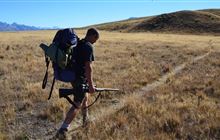Rusa deer hunting
Introduction
Learn more about one of the most elusive deer to be found in the New Zealand bush.Description
Size: Male height about 1060 mm at the shoulder and weighing 122 kg, females 810 mm shoulder height and weighing up to 70 kg.
Colour: Males dark reddish-brown summer coat changing to dark greyish-brown in autumn. Females pale yellowish-red in summer and greyish-red in winter. Chin, throat and underparts cream.
Antlers: Present in males only. Antlers cast December-January and new growth complete by May. Normally 3 points on each antler, with the inner tine longer than the outer and nearly parallel with the inner tine of the other antler.
Social behaviour: Wary and semi-nocturnal rusa spend much of the day holed up in thick vegetation cover. They live in small groups and have relatively small home ranges. Prefer mixed grass areas for feeding and often utilise adjacent farm paddocks and crops.
Reproduction: Rut commences mid-July and continues into August.
Males collect a harem of females. The actual male rusa's roar could be described as a short husky growl rather than the drawn out bellow of a red stag. Males roar infrequently perhaps only 2-3 times a day with concentrated activity early morning and late afternoon.
Males wallow and mark their territory with scrapes. While servicing these scrapes, males leave an unmistakeable scent that could be described as a pungent sickly sweet aroma.
Gestation period: About 240 days.
Birthing: Fawns are born March – April. Twins rare.
Nomenclature: Male = stag. Female = hind. Young = fawn/calf.
Where to hunt rusa deer
Rusa are the least widely distributed of all of the recognised deer species in New Zealand.
The north-western Te Urewera rusa population is well established, with their population well entrenched through the Galatea faces and associated catchments.
The forest type on much of the Galatea faces is quite scrubby and the rusa have adapted well to this habitat. Rusa are found more widely within Te Urewera, but with a somewhat patchy distribution.
In all cases, hunters should clearly identify the area they are permitted to hunt, as there are significant tracts of Māori land within Te Urewera.
Find a hunting block that has rusa deer
You can use the hunting block search function to find hunting areas that have rusa deer.
Search for a hunting block that has rusa deer.
Tips for hunting rusa deer
|
Characteristics/behaviour |
Hunting response |
|---|---|
|
Rusa are a medium sized deer. |
Rifle calibres of .243 and above are suitable for shooting rusa deer. |
|
Occupy areas of thick cover with warm aspect and adjacent to open grazing areas. |
Seek out suitable habitat and either:
|
|
Semi-nocturnal and active mainly early morning and late afternoon, lay up in thick cover during much of the day. |
Hunt or be at the stake out location early morning or late afternoon when deer likely to be more active. |
|
Rusa are rarely encountered on their own. |
When a rusa is sighted be alert as others may be in close proximity but hidden from view. |
|
Sign of rusa includes a network of well used trails and tunnels connecting bedding sites with feeding areas. |
Stake out areas where recently used tracking systems are found accessing feeding areas. |
Hunting seasons and ballots
In New Zealand there is no seasonal restriction to hunting rusa deer meaning generally they can be hunted throughout the year. There are however, instances where restrictions apply for specific reasons and periods when hunting is favoured.
Specific restrictions
- Some areas may be closed during periods of high fire danger.
- Occasionally an area may be closed on a temporary basis to enable research or other management to be undertaken without being compromised by hunting.
It is important to check for these conditions with:
| Murupara Office | |
| Phone: | 0800 275 362 |
| Fax: | +64 4 471 1117 |
| Email: | easternbop@doc.govt.nz |
| Address: |
Main Road, RD1 Murupara 3079 |
| Postal Address: |
PO Box 457 Whakatane |
| Full office details | |
Favoured hunting periods
- The rut is when the stags are most vocal, calling to attract the attention of hinds and are less cautious than other times. The roar lasts from July to the August.
- Spring is another favourable time of the year to hunt rusa deer. During spring deer can be seen coming out of the forest to feed on new grass and shrub growth.
International travel with hunting trophies
You may need CITES documentation to enter or leave New Zealand with your hunting trophy.

